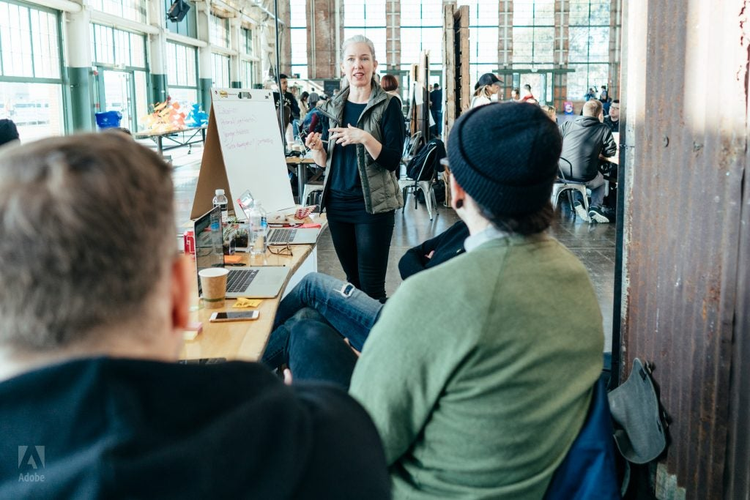Design on Demand


http://blogs.adobe.com/conversations/files/2016/05/Jamie-Myrold-UXdesignweek.jpg
The rise of cloud-hosted subscription software has driven a shift in design cycles. Instead of working for months to deliver a product, design efforts today are continuous. Iterations occur in steady drips and occasional torrents, requiring designers to find smarter, faster ways to access their creativity and test their concepts. On the heels of the latest product release, we caught up with the Adobe Document Cloud design team about best practices, lessons learned, and the constant tension between meeting the immediate needs of users and realizing the strategic direction of the product.
As Adobe shifted from releasing shrink-wrapped software to a cloud-hosted subscription model, the Adobe Document Cloud design team had to find new ways to manage workflows, capture user feedback, and stay fresh creatively.
“Our challenge is designing smarter, faster,” Jamie Myrold, senior director of Experience Design for Adobe Document Cloud, says. “With subscription-based software, there’s no mountain to climb every 18 months toward a big launch date. Instead, we aim to get design improvements and new functions into users’ hands as soon as possible.”
“We’re always conscious about where we focus our efforts at any given time,” says Jason Linder, senior experience design manager on the Document Cloud team. “And we routinely prioritize the experiences that will add the most value to the user.”
The team’s work falls, for the most part, into two buckets: implementation work, like customer requests and bug fixes, and vision work, which is the product roadmap.
To accomplish the implementation work, each team member may work on two or three projects at a time, exploring concepts and visions on one while rolling out features on another. “That’s good for the designers,” says Jason. “The constant challenges keep us fresh and give everyone a chance to grow. Ultimately, that makes it good for the customer, too.”
To accomplish the vision work, designers focus on the product roadmap. “We continually work alongside product management to hone and craft the roadmap, with an eye to ensuring we address the most critical experience issues and customer-facing features,” says Jamie. “We also create narrative workflow presentations, which tell a story of how someone would use a system of features. These help visualize the roadmap and rally the organization towards a common vision.”
Smarter, faster feedback
To prioritize work, the designers need to know what’s important to users. For that reason, the Document Cloud team uses simple ways to rapidly capture user feedback: tapping colleagues throughout the company who use Document Cloud in their daily work and using testing services.
“Before we test a nuanced interaction on customers, we do quick prototypes and send them to teams at Adobe,” says Liang-Cheng Lin, one of the team’s senior experience design managers. “We look at everything from the terminology we’re using to which functions get the best uptake. The results are quantitative, because everything is instrumented with analytics from Adobe Marketing Cloud that tell us exactly what’s ready for the market and what still needs to be tuned.”
After internal users give feedback, the changes are released to customers and the team seeks their feedback. “This is the same process we’ve always used, but now we do it more frequently,” says Vignesh Ramesh, a senior experience designer based in San Francisco. “We have a lot of conversations with product managers because they’re constantly in the field talking to customers, so they know the difficulties users face. We combine their input with known problems we’re trying to solve, make improvements, and then interview the same product managers, plus actual users, to get a fresh round of feedback.”
The team has learned to incorporate large volumes of feedback into the design process in a manageable fashion. “We’ve been able to abandon the old lab user studies and use case scenarios in favor of this analytic data,” Jamie says. “We used to recruit external users, schedule them to come into Adobe’s offices, create a test script, and give them a fairly high-fidelity prototype to interact with. These steps took a lot of time to set up and execute.” Now, the use of quantitative data combined with the use of testing services and internal testers allows the team to get feedback very quickly. “We gain a better understanding of how our work product is performing, and we gain it faster, ” Jamie says.
A marathon mindset
The continuous design cycle requires a very different mindset from designers. When software was released on an 18-month cycle, for example, the team would have set time to take a breath after a big launch. Now, they get on to the next thing right away.
But Jamie says that instead of causing burnout, designing on a continuum is actually less stressful than the monolithic cycle. “In the traditional design cycle, we had to make sure everything was buttoned up and perfect before release. Now, we’re okay with a few sharp edges because we never stop polishing and fine tuning. And, in the meantime, instead of waiting months to get an enhanced iteration of Document Cloud, they can start using new features immediately, wherever they are, on any device.”